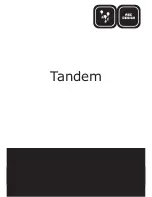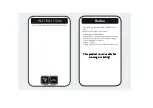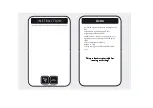
GSB3-40, GSB3-60, GSB3-80
1/2
+
-
BUS
BUS
+
-
BUS
BUS
Glass wall touch controllers
EN
Characteristics
- The wall controller with touch controls series GSB3 is a design element (controller) in the system
iNELS with elegant and comfortable control. Controllers are available in black (e.g. GSB3-40/B)
and white (e.g. GSB3-40/W) variants.
- Between each pair of touch buttons there is available a pair of indicator LEDs (green, red) to signal
not only the status of the controlled appliances, but also the status of any sensor or actuator in
the system.
- At the location of each touch button there is available a blue diode signaling the touching of the
given button. Touching may be signaled by a vibration impulse or sound tone - selectable in the
software iDM3.
- Controllers are 4-channels (GSB3-80), 6-channels (GSB3-60) and 8-channels (GSB3-80).
- All versions are in the same dimension as a basic modular wall-switch (94x94 mm), in design
LOGUS
90
.
- Each controller is equipped with a thermo sensor. It is equipped with two analog-digital inputs
(AIN/DIN), and it is possible to connect two potentialless contact or an external temperature sen-
sor TC/TZ (for example on fl oor temperature measurement).
- Controllers are equipped with an ambient light intensity sensor. From the basic information from
the sensor, it is possible to illuminate orientation blue diodes in the touch controls GSB3 or per-
form various actions in the software iDM3, e.g. illuminate light circuits in a hallway, etc.
- Advantages over conventional switches / buttons include space saving, signaling of any output
system, the ability to measure temperature and also the ability to connect external buttons or
detectors.
- Each channel (button) can control any actuator (appliance) in the system. It is also possible to
program various functions or fuction macro (set of functions) to each button. This allows you to
control several appliances with one button simultaneously.
- Each button (channel) can have diff erent functional modes beside lighting control:
a) Classic wall-switch: - upper button ON, bottom button OFF
b) Button controller (impulse relay): - fi rst press ON, second press OFF
c) Dimmer: - short press – ON/OFF
d) Time switch: - ON after press, automatically OFF after set time
e) Setting light scenes – for example: for watching TV:
- shutters down
- main light 30% intensity
- wall-lamps 50% intensity.
- Design series LOGUS
90
off ers glass frames in black and white color. These frames goes perfectly
with GSB3 wall buttons.
• Package includes:
- 2x 031.01 screws 3x20 mm flat head frame
General instrucions
Connection
Thermo sensors TC / TZ
2x input for fl oating contacts
(buttons, PIR etc.).
CONNECTION TO THE SYSTEM, INSTALLATION BUS
iNELS3 peripheral units are connected to the system through the BUS installation. Installation BUS
conductors are connected to the terminal units to BUS+ and BUS- terminals, wires cannot be interchanged.
For installation of BUS it is necessary to use a cable with a twisted pair of wires with a diameter of at least
0.8 mm, the recommended cable is iNELS BUS Cable, whose features best meet the requirements of the
BUS installation. Bearing in mind that in terms of all the properties is it is possible in most cases also use the
cable JYSTY 1x2x0.8 or JYSTY 2x2x0.8, however it is not recommended as the best option. In the case of a
cable with two pairs of twisted wires it is not possible to use the second pair of the other for modulated
signal due to the speed of communications; it is not possible within one cable to use one pair for one
segment BUS and the second pair for the second segment BUS. For installation of BUS it is vital to ensure
that it is kept at a distance from the power lines of at least 30 cm and must be installed in accordance with
its mechanical properties. To increase mechanical resistance of cables we recommend installation into
a conduit of suitable diameter. BUS topology installation is free except for the ring, wherein each end of
the bus must terminate at the terminals BUS + and BUS- peripheral unit. While maintaining all the above
requirements, the maximum length of one segment of the installation BUS can reach up to 550 m. Due
to the data communication and supply of units in one pair of wires, it is necessary to keep in mind the
diameter of wires with regards to voltage loss on the lead and the maximum current drawn. The maximum
length of the BUS applies provided that they comply with the tolerance of the supply voltage.
CAPACITY AND CENTRAL UNIT
It is possible to connect to the central unit CU3-01M or CU3-02M two independent BUSes by means
of terminals BUS1+, BUS1- and BUS2+, BUS2-. It is possible to connect to each BUS up to 32 units, so it
is possible to connect directly to the central unit a total of 64 units. It is necessary to comply with the
requirement of a maximum load of one BUS line - maximum up to 1000 mA current. When connecting
units which draw greater than 1A, BPS3-01M with 3A sampling can be used. It is the sum of the rated
currents of the units connected to the BUS line, other units can be connected using the units MI3-02M,
which generate further BUSes. These are connected to the CU3 unit via the system BUS EBM and you can
connect a total of 8 units via EBM BUS to the central unit MI3-02M.
SUPPLYING THE SYSTEM
For supplying power to system units, it is recommended to use the power source of ELKO EP titled PS3-
100/iNELS. We recommend backing up the system with backup batteries connected to the source of
PS3-100/iNELS (see sample diagram of connecting the control system).
GENERAL INFORMATION
To operate the unit, it is necessary that the unit is connected to a central unit CU3 series, connected to the
central unit of the system CU3, or to a system that already contains this unit as its expansion to include
further system.
All unit parameters are set through the central unit CU3-01M in the software iDM3.
There is LED diode on the PCB for indication of supply voltage and communication with the central unit
series CU3. In case that the RUN diode fl ashes at regular intervals, so there is standard communication
between the unit and BUS. If the RUN diode lights permanently, so the unit is supplied from BUS, but there
is no communication between BUS and unit. In case that RUN diode is OFF, so there is no supply voltage
on the terminals BUS+ and BUS-.




















